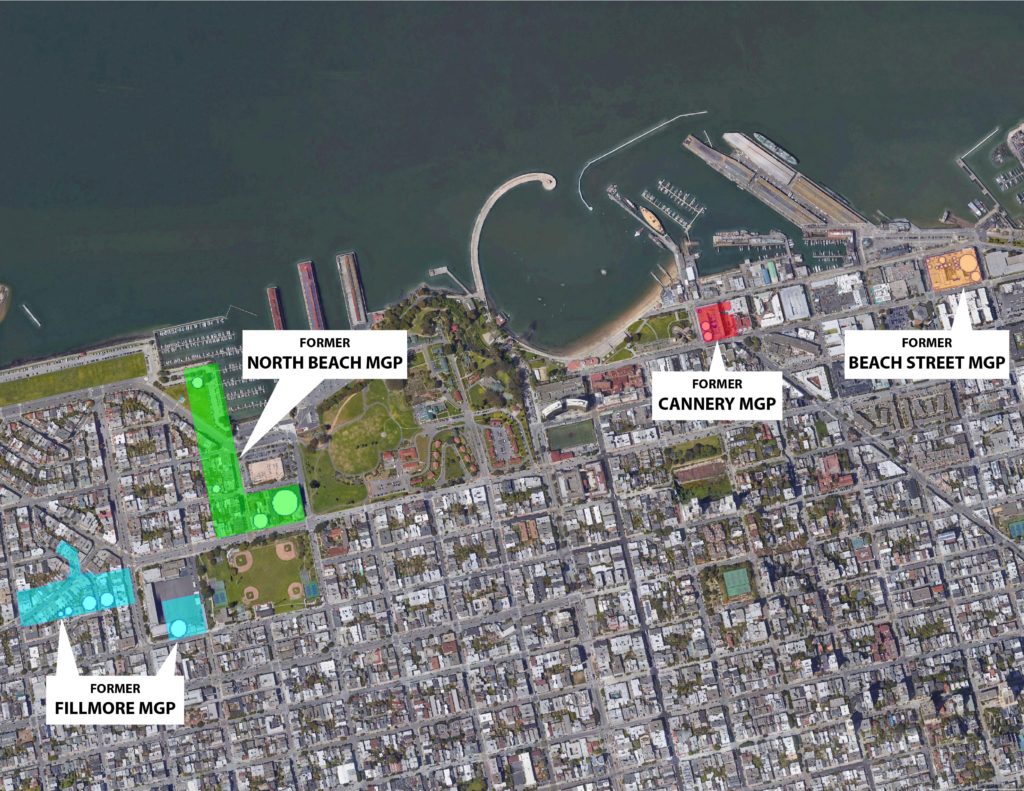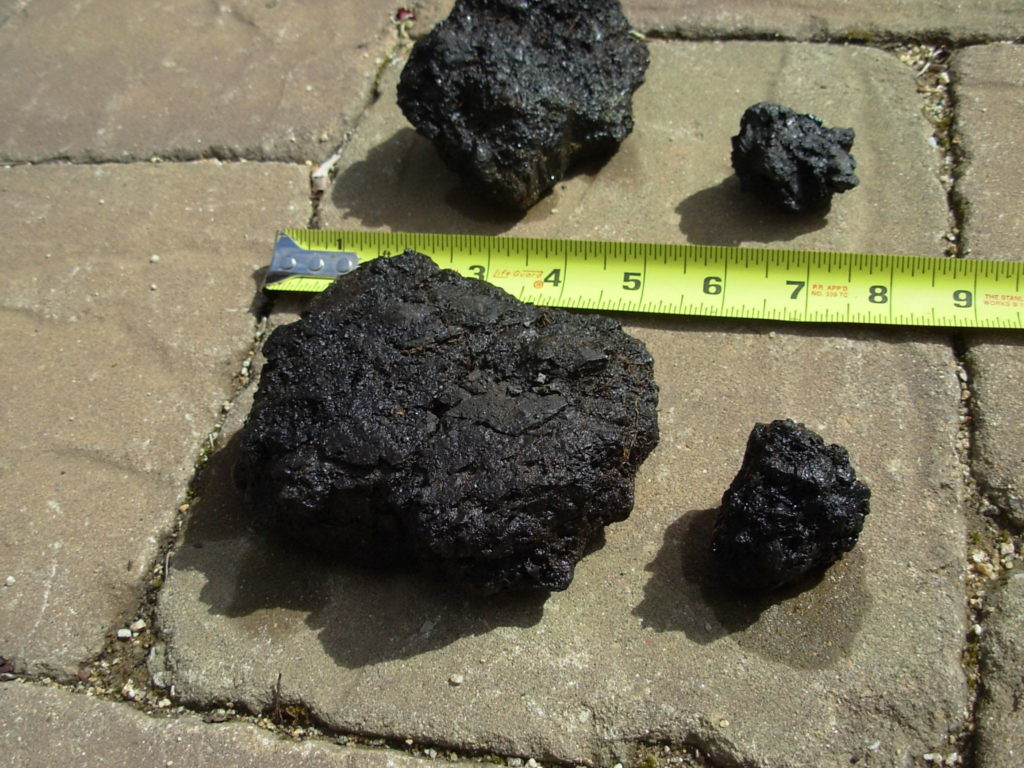Company Power
Company Shame
MGP Contamination
Hazardous chemicals created by Manufactured Gas Plants (MGPs) a hundred years ago remain in the environment near four MGPs along San Francisco’s northern waterfront. Gas used for lighting, heating, and cooking was manufactured from coal and oil in the era before natural gas. The process created hazardous chemicals which were uneconomical and disposed of in the ground and nearby waters. Contamination from these MGPs continues to enter San Francisco Bay and impact the environment today. The action and inaction of a supposedly responsible party impacts people living and working in the area today.
This website provides information about MGP contamination in an easy to access format. A key feature is an interactive MGP Map which allows viewing the impacts by location. Objects on the map can be drilled down for more specific data when desired. An overview of the map and basic instructions can be found here or by going to the Map page found on the top navigation bar. The button seen below opens the interactive MGP Map in a separate window.
Contamination is a broad topic with many interconnecting parts. Information can be accessed below and on separate pages in this website – see the top navigation bar.
You are invited to explore.
Four MGPs in time
Four MGPs were built between 1880 and 1900 in the area now known as the Marina and Fisherman’s Wharf. Three were damaged by the 1906 earthquake and no longer produced gas but continued to store and transport gas manufactured at other MGPs. The fourth MGP survived and continued to manufacture gas into the 1930s at which time natural gas was gradually introduced into San Francisco. Demolition of the last structures from the era occurred during the 1950s and 1960s. Foundations and other underground facilities were generally not removed. Contamination in the form of hazardous chemicals associated with MGPs have been found near each MGP starting in the 1970s. All four MGPs averted becoming Superfund sites through inadequate testing and a supposedly responsible party stepping forward in the 1980s. In the 1990s, the supposedly responsible party deliberately avoided its responsibility by unethical and allegedly criminal acts that have not (yet) been addressed by the Department of Justice. A so-called environmental project that began in 2010 continues the wrongdoing into the present day.
Contamination is bubbling into San Francisco Bay
An unidentified boat owner took this video in 2012. The substance bubbling to the surface was identified as MGP contamination from a deposit of coal tar extending onshore and offshore in the Marina. Created and disposed of 100 years ago, this coal tar deposit remains on the edge of the Bay and contamination can still be seen today bubbling to the surface during low tides. No one knows the amount of hazardous chemicals entering the Bay but it is known that this visible contamination is coming from a Known Seep near the dogleg in Gashouse Cove. The prospect of undetected seeps from this coal tar deposit, or seeps from suspected but as yet unconfirmed coal tar deposits, is worrisome.
Contamination is in the yard
Black Rocks found near the surface of a home garden in 2010 contain hazardous chemicals in concentrations rivaling coal tar. Similar substances have been found at other locations throughout the Marina. In 2019, an unsettling discovery was made: liquid coal tar was discovered within three feet of the surface in another home garden. The obscure way the 2019 discovery was communicated to the public — there was no public notification, the finding was buried deep in a technical report — is a health and safety issue.
Contamination is widespread
Testing near three of the four MGPs along San Francisco’s northern waterfront have found pockets with significant concentrations of hazardous chemicals in soil, in groundwater, and in Bay sediments. (The supposedly responsible party’s refusal to test the fourth MGP is subject to a lawsuit at this writing.) Static images called heat maps illustrate the location and concentrations of hazardous chemicals. The available heat maps are unfortunately incomplete because testing is incomplete. Testing is incomplete because there has not been a comprehensive, thorough, and (frankly) honest investigation of MGP contamination in the Marina and Fisherman’s Wharf. There has never been a fully trustworthy investigation and there won’t be any unless the public recognizes the motivation of the powerful company that controls all actions related to MGP contamination.
Marina contamination zones
A 2021 Consent Decree designated broad areas of the Marina as potentially contaminated. Area A, which includes the two Marina MGPs, may be contaminated from the surface down. Area B corresponds to the former lagoon and it may be contaminated from the water table down. A Community Notice alerted owners of unremediated properties in area A with photographs and language (“Soils on your property, including some located near the surface, may contain levels of hazardous materials… some of which may reasonably be expected to be carcinogens.”). Similar notifications will go to persons known to be working in the public right-of-way. The latter will also include suggestions about health and safety procedures and potential reimbursement for handling contaminated materials. These are baby steps in the effort to deal with MGP contamination in the neighborhood.
The fox guarding the hen house
Contamination is an unpleasant subject but it must be addressed if the problems from it are to be resolved. The reason this very old contamination is still impacting people and the environment today is the power utility company responsible for it has the power to control what is and what is not done about it. That company acts in its own interest and not in the interest of the public. Regulation has proved ineffective. It is not practical to make regulation strong enough to offset the power of a company that cannot be allowed to fail. There will be no rational solution to contamination in the Marina and Fisherman’s Wharf until these facts are recognized and decision-making placed in the hands of an independent third party.
Full Disclosure
The creator of this website is a plaintiff in a lawsuit stemming from contamination created and distributed at Manufactured Gas Plants formerly located along San Francisco’s northern waterfront [Case # 14-04393-WHO]. Broad environmental claims in that lawsuit allege PG&E violated the Clean Water Act, the Resource Conservation and Recovery Act, and related California laws. He created this website out of concern for the community and the environment, and as is his right under the First Amendment.



